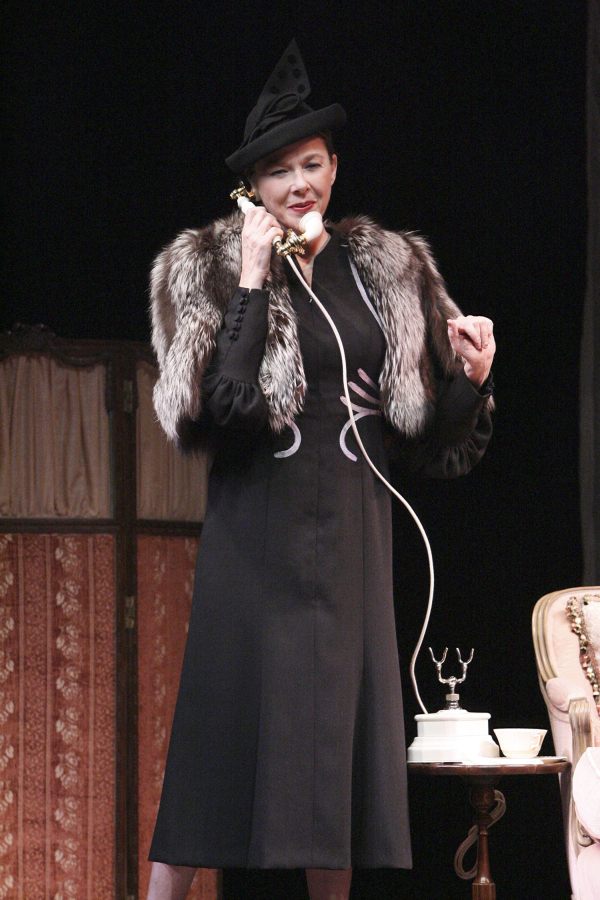America's Greatest Woman Playwright (Maybe)

As a small child, multiple Tony nominee and Obie Award winner Dana Ivey was taken by her actress mother to see the legendary lady. "We were up in the balcony," Ivey recalls. "She was far away on the stage, in a pool of light. As a rule, I don't much like single-person shows, but just remembering her alone on a big stage, in that pool of light, must somehow have been formative."
It might well have been. The legendary lady, whose 130th birthday the world will celebrate this December, was Ruth Draper (1884-1956). Her solo performances, preserved on audio recordings made 60 years ago, have kept her enchantment alive. Idolized in her own time, Draper achieved the magic all by herself, with nothing onstage except her, a shawl, a chair, and occasionally a small table. It was enough to earn her four decades of sold-out houses, critical raves, and the adoration of her most eminent colleagues. John Gielgud ranked her with Martha Graham as "the greatest individual performer[s] America had yet produced," while Uta Hagen declared, "I was in awe of Ruth Draper. Each of her characters was like a Rembrandt on stage." Last spring, Annette Bening joined the long list of actors tempted to test their skills against the challenge of Draper's texts, with an evening of four Draper monologues at L.A.'s Geffen Playhouse.

Human character, in all its depth and specificity of detail, is the key to the longevity of Draper's art. "Ruth Draper and Her Company of Characters," said the billing on her programs, and her lone figure could evoke multitudes — either through a single character's reaction to a horde of unseen others, or by a quick switch from one persona to the next, accomplished through a shift of the shawl and an altered vocal tone. One celebrated Draper solo, "In a Church in Italy," gave her six roles in three languages, from a desperate Italian beggar woman to a bossy American tour-group leader. In her best-known work, "The Italian Lesson," the sole speaker, a culture-vulture-ish wealthy socialite, gets distracted from the opening lines of Dante's Inferno by an avalanche of interruptions, including everything from surplus opera tickets to the arrival of a new puppy.
Because Draper was finally persuaded, late in life, to record her pieces, listeners today still relish the hilarity that audiences seeing her found in "The Italian Lesson" and other high-society skewerings, like "Showing the Garden," "Opening a Bazaar," and "Doctors and Diets." The innumerable theater artists who love her, though, see beyond the giddy laughs these items provoke, to the passion for exactitude that grants three-dimensional individuality to her every character, seen or unseen. "She gave me the courage to listen and to observe," says actress-director Sondra Lee, famed for her performances opposite Mary Martin in Peter Pan and Carol Channing in Hello, Dolly! "That's great acting."
The word "courage" is decidedly relevant. Not only did Draper spend her onstage decades alone out there, with one costume accessory, one piece of furniture, and no props. She did so as a woman — and one wholly dependent, to boot, on her own material. The range and depth of her works, which go far beyond the airy fooleries of social comedy, suggest that she may rank among America's greatest women playwrights. "The two words that come to mind are 'craftsmanship' and 'empowerment,'" says Darko Tresnjak, Tony-winning director of A Gentleman's Guide to Love and Murder. "She had the career she wanted and did not wait for someone else to cast her."
That career remains all the more surprising because Draper dates from an era that actively discouraged women of her class from having a career at all. Her father was a prominent Park Avenue physician; her mother's father, Charles Anderson Dana, edited and published the Sun, then one of New York's leading newspapers. Draper began her solo career giving parlor performances, first at family gatherings, and then at high-society charity events. She got encouragement from family friends who had themselves partly broken free of society's restrictions to pursue the arts, notably Henry James.

(© Joan Marcus)
Word of her gifts spread quickly. She was already on the cusp of her professional career when she turned to James for advice: Should she offer herself in the marketplace, by auditioning for other playwrights' works, or perhaps confine herself to writing only? "My dear child," the great novelist told her, in his customary halting speech, "you have woven your own — very beautiful — little Persian carpet. Stand on it!"
And stand on it she did, for the next 40 years. Apart from one brief early venture in a script by someone else (A Lady's Name by Cyril Harcourt, on Broadway in 1916), she played nothing but her own creations, not even attempting the monologue that James himself had written for her. "I think," she mused later, "he was rather disappointed."
But other writers, even of James's stature, would have been superfluous. The bare stage on which she stood, alone in that pool of light, teemed with people: She had the imaginative force to make her audiences see multitudes. Kenneth Tynan, seeing her for the first time, in London in 1952, wrote, "It seems, in passing, absurd to use a singular verb in connection with so plural a player," adding that "Ruth Draper are now at the height of their career, and you only have six more weeks in which to see them." Tynan was updating an old critical saw: In 1921, Alexander Woollcott, covering one of Draper's earliest Broadway gigs for the New York Times, suggested that she revise her billing to read, "Ruth Draper and the Rest of Humanity."
I'll have much more to say about Draper, and what artists currently at work have learned from her, next week. But in the meantime, if the above has given you a craving to hear her at work, she's available on CD.










